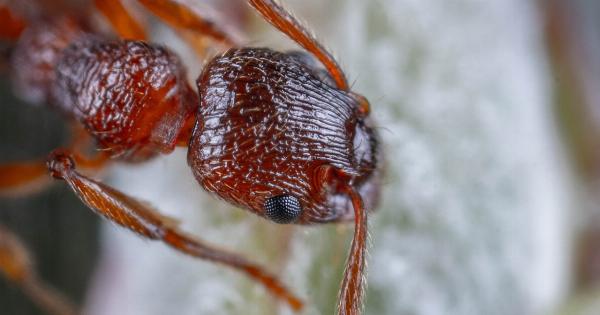Ants, often regarded as tiny but remarkable creatures, form complex colonies and exhibit sophisticated network behaviors. Their collective intelligence and organization make them one of the most successful groups of insects on the planet.
However, when ants infiltrate our homes or invade our gardens, their peaceful coexistence becomes a nuisance. Controlling and managing a colony of ants can be a challenging task, requiring innovative techniques and strategies that go beyond conventional pest control methods.
In this article, we will explore the most enigmatic ways to control and manipulate ant behavior, keeping their influence at bay.
Understanding Ant Behavior
Before delving into ant control techniques, it is crucial to understand the fundamental principles of ant behavior.
Ants exhibit complex social structures, with each individual assuming a specific role and contributing to the overall functionality of the colony. The key roles within a colony include the queen, workers, soldiers, and foragers.
The queen’s primary task is reproduction, and she is responsible for laying eggs that give rise to the entire ant population.
Workers, on the other hand, are responsible for tending to the queen and her offspring, building and maintaining the nest, and gathering food. Soldiers defend the colony against potential threats, while foragers search for food sources outside the nest.
Enigmatic Ant Control Techniques
The conventional methods of ant control, such as pesticide application or physical barriers, often provide temporary relief but fail to address the root causes of ant infestation.
To truly manipulate and control a colony of ants, we need enigmatic techniques that target their behavior and disrupt their communication systems.
1. Ant Baiting
Ant baiting involves the use of food-based toxins or growth regulators that are attractive to ants. The bait is placed in strategic locations where ants are commonly seen.
When ants discover the bait, they transport it back to the colony, where it is shared with the queen and other members, eventually leading to their elimination.
2. Navigational Disruption
Ants rely on sophisticated navigational systems, including scent trails and visual cues, to communicate and locate food sources. By disrupting their navigation, ants can be disoriented and unable to retrieve food effectively.
One technique involves placing obstacles or diverting the scent trails, confusing the ants and preventing them from reaching their destination.
3. Biological Controls
Biological controls involve introducing natural predators or parasites that specifically target ants.
For instance, certain species of flies lay eggs on ants, which eventually develop into larvae that feed on the ant’s body, leading to their eradication. Biological controls are environmentally friendly and provide long-term ant management solutions.
4. Ant Repellents
Ant repellents are substances that deter ants from entering specific areas. These repellents can be natural, such as vinegar or essential oils, or synthetic chemicals specifically formulated to repel ants.
By creating a barrier of repellent, ants can be prevented from entering homes, gardens, or other areas of interest.
5. Colony Destruction
In situations where ant colonies cannot be controlled or relocated, destroying the nest becomes a viable option. This can be achieved through methods like flooding the nest with water or applying insecticides directly to the nest entrance.
However, colony destruction should only be considered as a last resort, as it may disrupt the ecological balance and have unintended consequences.
6. Surveillance and Monitoring
Effective ant control requires continuous surveillance and monitoring of ant activity. By identifying the ant species and understanding their behavioral patterns, targeted control methods can be implemented.
Regular inspections of potential entry points and nesting areas enable early detection and intervention, preventing full-blown infestations.
7. Integrated Pest Management (IPM)
Integrated Pest Management is a holistic approach to pest control that focuses on sustainable and long-term solutions.
IPM combines multiple techniques, such as biological controls, ant baiting, and physical barriers, to manage ant populations effectively while minimizing environmental impact. This approach emphasizes prevention, monitoring, and intervention based on careful assessment.
8. Using Natural Remedies
Natural remedies, such as diatomaceous earth and boric acid, can be effective in controlling ants. Diatomaceous earth is a natural powder made from fossilized algae that punctures the exoskeleton of ants, dehydrating and killing them.
Boric acid acts as a stomach poison when ingested by ants, causing them to perish. These remedies provide non-toxic alternatives to conventional pesticides.
9. Reproductive Suppression
Queens are vital to the survival and growth of ant colonies. By implementing techniques that target the queen’s reproductive capabilities, ant populations can be effectively controlled.
Reproductive suppression methods can include the removal of queens, hormonal disruption, or sterilization techniques that prevent the production of viable eggs.
10. Alternative Nesting Solutions
When ants find their way into our homes, it is often due to the convenience and accessibility of resources.
Providing alternative nesting solutions, such as ant farms or containers specifically designed for ants, can lure them away from our living spaces and into controlled environments. This approach allows for observation and better management without disturbing the natural balance outside.
Conclusion
Controlling and managing a colony of ants can be a complex task, requiring innovative and enigmatic techniques to disrupt their behavior and communication systems.
From ant baiting to reproductive suppression, there are various methods available to keep ant populations under control. It is essential to prioritize long-term and sustainable solutions that minimize environmental impact while effectively managing ant infestations.
By understanding ant behavior and implementing the most suitable strategies, we can coexist peacefully with these incredible creatures while minimizing any inconvenience they may pose.





























